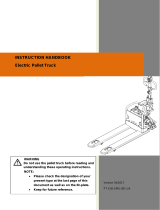
SLNM, Manual
Copyright 2015 Vestil Manufacturing Corp.
Page 11 of 14
Maintenance and Inspections:
Inspections: ALWAYS review the following warning messages and procedures
BEFORE inspecting the STACKER.
DO NOT use the STACKER if an inspection re
veals structural damage. Structural damage
includes, but is not limited to, cracked welds, warping or other deformation of the cylinder brackets, forks, front
rollers and wheel(s), handle, or the housing that protects the electrical components.
If an inspection exposes any problem, restore the STACKER to normal operating condition BEFORE
returning it to regular service. The STACKER must not be used until all repairs have been completed.
According to B56.1-2005:
A “User” is “a person or organization responsible for employing powered industrial trucks.” Therefore, the person
or business that owns the STACKER is a user.
“Authorized” means any person designated by the user to operate or maintain the equipment. In other words, the
owner, most likely your em
ployer, is responsible for training and selecting people to inspect and maintain the
STACKER. NOTE: A user may choose to contract with a person or an organization for maintenance services.
Vestil is not responsible for the actions of independently contracted maintenance service providers.
DO NOT use brake fluid or jack oil in the hydraulic system. If oil is needed, use an anti-wear hydraulic oil,
viscosity grade 150 SUS at 100°F, (ISO 32 @ 40°C), or a non-synthetic transmission fluid.
Only use replacement parts either supplied or approved by the manufacturer.
The person(s) authorized by
the end-user to inspect the STACKER must do so before it is used for the first time,
and before each subsequent use. If the STACKER is rarely used, inspect the unit at least once per month, or before
each use, whichever is more frequent. Before the inspection, a) disconnect the battery, and b) either chock the
wheels or lift the STACKER until the drive wheels no longer contact the ground.
Inspect the pallet truck prior to each use. Specifically look for:
1. Frayed
wires;
2. Oil leaks;
3. Pinched or damaged hoses;
4. Structural damage: cracked welds, warping or other deformation of the cylinder brackets, forks, front rollers
or drive wheel(s), handle, or the housing that protects the electrical components;
5. Proper function of all limit switches;
6. Proper horn operation;
7.
Normal battery condition: clean, not leaking electrolyte solution, secure connections with both terminals.
Also make sure that the battery is immobilized so that it cannot move during operation.
8. Proper rotation of all wheels.
Inspect the MHT each month:
1. Oil level: raise the forks to the maximum height; when the cylinder(s) are properly filled, the oil level should
be 1-1/2 to 2 inches below the reservoir fill hole. Return the forks to the fully lowered position.
2.
Damage to or excessive wear of:
a. Pivot points;
b. Hydraulic hoses;
c. Electric wires;
d. Retaining rings for the rollers, drive wheels, and all pivot points;
e.
Bearings
3. Wobbliness or looseness of rollers and/or drive wheel
s;
4.
Proper function of the hand or foot actuated mechanisms;
5. Proper battery water level;
6. Unusual noise or abnormal movement during operation;
7.
Legibility and undamaged condition of all product labels.
Maintenance: the end-user
must implement a scheduled maintenance program to ensure the proper function and
safety of the lifter. Pages 12-13 of ANSI/ITSDF standard B56.1-2005 describe some recommended maintenance
procedures, and the following steps should be utilized in conjunction with those recommendations.
The user is responsible for training persons to work on the STACKER. “Work on” refers to operating,
loading, cleaning, servicing, maintaining, or repairing the product. ONLY trained, authorized maintenance personnel
or independent contractors chosen by the user should perform inspection, maintenance, or repair work.

















